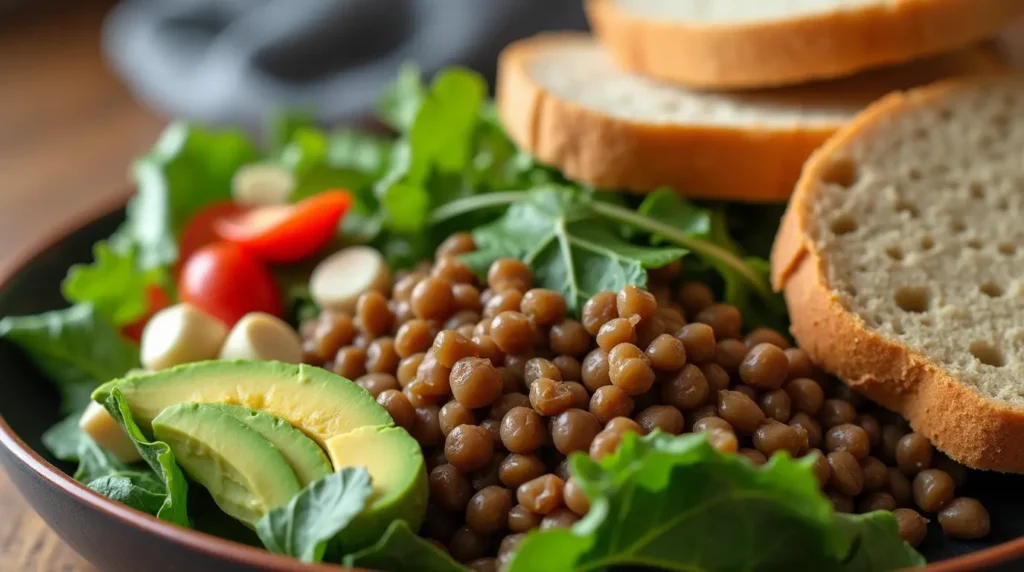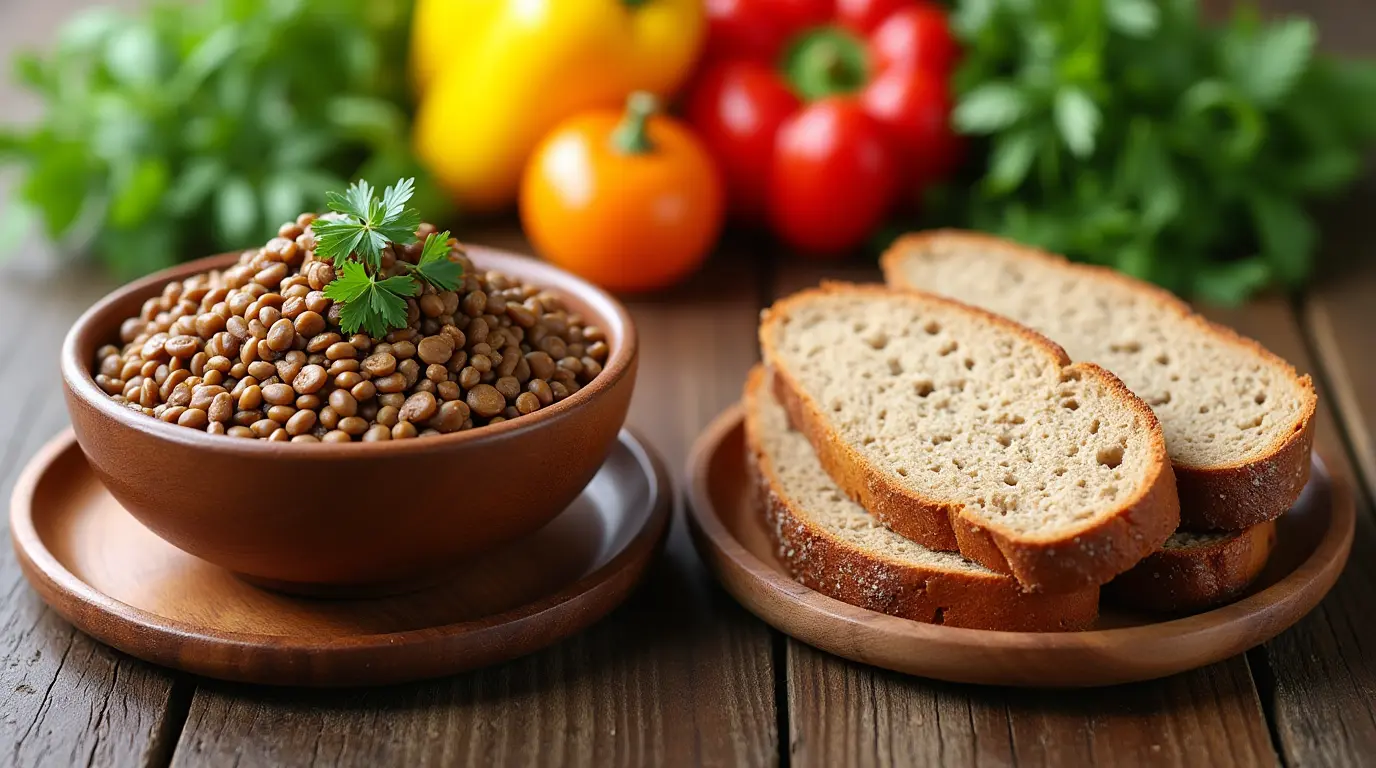The debate on the best food staples for a healthy diet is ongoing. Many wonder if lentils are better than bread. With more people choosing plant-based diets, knowing the nutritional values of these foods is key.
This article compares lentils and bread in detail. We look at protein, fiber, glycemic impact, and environmental effects. This will help you decide which is better for you.
Key Takeaways
- Lentils are a nutrient-dense legume packed with protein, fiber, and essential minerals, while bread is a grain-based staple with varying nutritional profiles depending on the type.
- Lentils typically have a lower glycemic index, meaning they have a gentler impact on blood sugar levels compared to many types of bread.
- Lentil production generally has a smaller environmental footprint than modern industrial bread production, making them a more sustainable food choice.
- Both lentils and bread can be valuable components of a balanced diet, but the specific nutritional needs and dietary preferences of the individual should be considered when determining the optimal choice.
- Incorporating a variety of nutrient-dense plant-based foods, including both lentils and whole grain breads, can contribute to a well-rounded and healthy diet.
Understanding Lentils and Bread: Basic Nutritional Profiles
Exploring the nutritional differences between lentils and bread is key. Both are important for our health, but they have different nutritional values.
Key Nutrients in Lentils
Lentils are packed with protein sources and are a great plant-based option. They also have essential vitamins, minerals, and fiber content. Lentils are rich in folate, iron, and magnesium, making them very nutritious.
Essential Components of Bread
Bread is mainly made of carbohydrates from grains like wheat, rye, or barley. It gives us energy but has less protein content than lentils. The fiber in bread varies based on its type and ingredients.
Caloric Content Comparison
Lentils and bread have different calorie counts. Cooked lentils usually have fewer calories than bread. This makes lentils a better choice for those watching their calorie intake.
Knowing the nutritional profiles of lentils and bread helps us make better food choices. It helps us pick the food that fits our nutritional needs and preferences.
Protein Content: Comparing Legumes vs Grains
The debate between legumes like lentils and grains like bread often focuses on protein. Knowing the protein quality and amino acid profiles helps you choose wisely. This supports your health and fitness goals.
Complete vs Incomplete Proteins
Proteins are vital and made of amino acids. Complete proteins have all essential amino acids. Incomplete proteins are missing some. Lentils and bread are incomplete proteins.
Amino Acid Profiles
It’s key to eat various protein sources for all amino acids. Lentils are rich in lysine, arginine, and tryptophan. Bread has more methionine and cysteine. Mixing legumes and grains creates a complete protein.
Plant-Based Protein Quality
- Lentils are a high-quality plant-based protein, containing all essential amino acids, though in varying amounts.
- The protein quality of bread can be improved by fortifying it with additional protein sources, such as soy or other plant-based ingredients.
- When following a plant-based diet, incorporating a diverse range of protein sources, including legumes, grains, nuts, and seeds, can help you meet your protein needs.
Both lentils and bread are great for a balanced diet, offering unique benefits. Understanding protein quality helps you make better choices. This is true whether you prefer plant-based options or a mix of legumes and grains.

Fiber and Digestive Health Benefits
Lentils and bread have big differences in fiber content. Lentils pack a punch with 15 grams of dietary fiber in one cup. Meanwhile, a slice of bread has only 2-3 grams. This big difference affects your digestive health a lot.
Lentils are great for your gut because of their high fiber content. Fiber feeds the good bacteria in your stomach. This helps keep your bowels regular, prevents constipation, and may lower the risk of IBS and diverticulitis.
Bread, especially the white kind, has less fiber content. Refined grains, like those in white bread, lack the bran and germ. This makes white bread lower in fiber.
Eating more plant-based diet foods like lentils can help. They increase your fiber content and support your digestive health. Choosing the right foods can keep your gut happy and healthy.
“Fiber is essential for a healthy digestive system, and lentils are an excellent source of this vital nutrient.”
Glycemic Index and Blood Sugar Impact
The glycemic index (GI) is key for managing blood sugar. It shows how a food affects your blood sugar. Lentils and bread have different impacts, helping you choose better foods.
How Lentils Affect Blood Sugar
Lentils are low in GI, meaning they don’t raise blood sugar much. They’re full of fiber and protein, which slow down carb digestion. This helps keep blood sugar stable, good for those with diabetes or anyone wanting to control blood sugar.
Different Bread Types and Glycemic Response
Not all bread is the same in GI. White bread, made from refined grains, quickly raises blood sugar. But whole-grain breads, like whole wheat or rye, are lower in GI. They have more fiber, slowing down carb digestion.
Knowing the GI of foods helps manage blood sugar. Adding sustainable foods like lentils to your diet supports your health.
“Maintaining stable blood sugar levels is essential for overall health, and understanding the glycemic index of the foods you eat can be a powerful tool in achieving this.”
Sustainability and Environmental Impact
Choosing sustainable foods is key. The way we make lentils and bread affects our planet. Let’s look at how these foods impact our environment.
Carbon Footprint Comparison
Lentils have a smaller carbon footprint than wheat bread. Lentils use less energy because they fix nitrogen in the soil. Wheat, however, needs more fertilizers, which increases carbon emissions.
Water Usage in Production
Water is precious, and food production uses a lot of it. Lentils need less water than wheat. This makes lentils better for areas with water shortages.
Agricultural Considerations
Lentils are better for the soil. They improve soil health and cut down on synthetic fertilizers. Wheat, grown alone, can harm the soil and need more fertilizers.
FAQ
Are lentils better than bread in terms of nutrition?
Both lentils and bread offer nutritional benefits. The choice between them depends on your dietary needs and preferences. Lentils are packed with protein, fiber, and vitamins. They are more nutritious than most breads.
Bread, however, is a good source of complex carbs, B vitamins, and other nutrients. It depends on the type of bread you choose.
How do the protein sources in lentils and bread differ?
Lentils are a top-notch plant-based protein source. They have all the essential amino acids, making them a complete protein. Bread, made from grains, lacks some amino acids, making it an incomplete protein.
This means lentils are better for protein, especially for vegetarians and vegans.
What are the fiber benefits of lentils compared to bread?
Lentils have much more dietary fiber than most breads. Their fiber helps with digestion and gut health. Bread also has fiber, but less than lentils.
The type of grains and whether the bread is whole grain or refined flour affect its fiber content.
How do lentils and bread affect blood sugar levels?
Lentils have a lower glycemic index than most breads. This means they don’t raise blood sugar as much. They are low in carbs and high in fiber, slowing down glucose absorption.
Many breads, especially those with refined flour, can raise blood sugar more. This is a concern for some people.
Which is more sustainable, lentils or bread?
Lentils are more environmentally friendly than many breads. They require less water and have a smaller carbon footprint. Lentils also help fix nitrogen in the soil, reducing fertilizer needs.
Bread production, however, can be resource-intensive. It involves growing grains and energy for milling and baking. The sustainability of bread depends on its ingredients and production methods.
Are lentils OK on a low-carb diet?
Yes, lentils can fit into a low-carb diet when consumed in moderation. They are nutrient-dense and high in fiber, which lowers their net carb content. For example, a 1/2 cup of cooked lentils contains about 20 grams of carbs, but 8 grams are fiber, leaving 12 grams of net carbs. While not ideal for strict keto diets, they work well in less restrictive low-carb plans.
Which bread has the lowest carbs?
Low-carb bread options include:
- Cloud Bread: 1-2 grams of net carbs per serving.
- Almond Flour Bread: 2-4 grams of net carbs per slice.
- Flaxseed Bread: 1-2 grams of net carbs per slice.
- Coconut Flour Bread: 2-3 grams of net carbs per slice.
These options are gluten-free and excellent for keto or low-carb diets.
Is lentil bread healthier than regular bread?
Yes, lentil bread is generally healthier than regular bread due to its higher protein and fiber content. It provides essential nutrients like iron and folate and has a lower glycemic index than most wheat breads. However, lentil bread has 15-20 grams of carbs per slice, so portion control is essential for low-carb diets.
Is lentil flour high in carbs?
Lentil flour has moderate carbohydrate content compared to wheat flour. A 1/4 cup serving contains approximately 11-13 grams of carbs, which is less than the 24 grams in wheat flour. Additionally, its high protein and fiber content make it a more balanced option for baking and cooking.
Is lentil bread high in carbs?
Lentil bread has moderate to high carbs compared to other low-carb bread alternatives. A slice contains 15-20 grams of carbs, depending on the recipe. While it’s not as low in carbs as almond or cloud bread, it offers nutritional benefits like fiber and protein, making it a healthier option than traditional wheat bread.
Summary
Lentils and lentil-based products can be included in low-carb diets with proper portion control. Low-carb bread options like almond or flaxseed bread are better for stricter carb limits, while lentil bread and flour offer higher protein and fiber content for balanced diets. Always consider your dietary needs when incorporating these foods.

